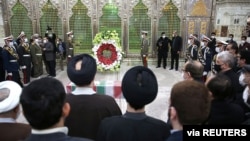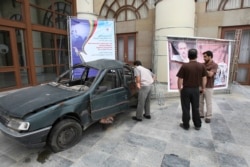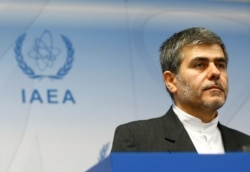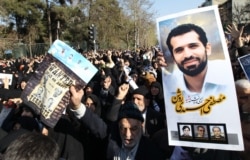The assassination of Iran’s nuclear scientist Mohsen Fakhrizadeh by unknown assailants last week is the latest in a string of targeted killings of figures behind Tehran's atomic program.
Since 2007, six of the country’s top nuclear scientists and researchers have been killed and one has been wounded under mysterious circumstances. In nearly all cases, the Iranian government blamed Israel and/or the United States. Israeli officials have neither confirmed nor denied the allegations. U.S. officials have denied playing any role in the killings.
Here are the top Iranian nuclear scientists who Iran publicly acknowledged were killed, have died, or were wounded in recent years.
Ardeshir Hosseinpour, Age 45
Died January 15, 2007
Hosseinpour was a nuclear physics scientist and a lecturer at Shiraz University and the Malek Ashtar University of Technology in Isfahan. An expert in the field of electromagnetism, he was one of the founders of the “Nuclear Technology Center of Isfahan,” the genesis of Natanz nuclear facility where he continued his research until his mysterious death on January 15, 2007.
Iranian state-run Central News Unit reported that Hosseinpour and several of his coworkers lost their lives from gas poisoning during their nuclear work in Isfahan. However, American private intelligence company and research group Stratfor in a February 2007 report claimed he was killed by Israel’s intelligence agency, Mossad.
Masoud Ali Mohammadi, 50
Killed January 12, 2010
Mohammadi was a nuclear scientist and a PhD graduate student of physics from the Sharif University in Tehran. He had over 50 published papers and articles in academic journals and was reportedly named one of the key scientists in the advancements related to particle accelerator machines and atom smashers.
On January 12, 2010, Mohammadi died in front of his house in Tehran when a booby-trapped motorcycle parked next to his vehicle exploded.
The Iranian government initially accused Israel and the U.S. for his assassination. Then-foreign ministry spokesman Ramin Mehmanparast called it a “cohort operation by Zionist regime of Israel, the U.S. and their allies in Iran.”
The U.S. Department of State, however, rejected the U.S. involvement. Israel remained silent.
Majid Shahriari, 45
Killed November 29, 2010
Shahriari was an Iranian high-ranking physics scientist and a nuclear engineer with expertise in nuclear chain reactions. He graduated from top Amir Kabir (Polytechnics) University of Tehran and was a professor at Shahid Beheshti Tehran University. Shahriari was reportedly named a key figure in the advancement of technologies related to the nuclear enrichment in Iran’s Atomic Energy Organization.
He was assassinated on November 29, 2010 by a magnetic bomb attached to his car by a team of assassins on a motorcycle while he was driving on Artesh highway in Tehran.
Some Iranian authorities accused Israel of his killing. Then-interior minister Mostafa Mohammad Najjar claimed cooperation between the CIA and the Mossad in the killing.
Israel did not comment on this. Philip J. Crowley, then-U.S. State Department spokesman, did not address the Iranian accusations in detail. “All I can say is we decry acts of terrorism wherever they occur and beyond that, we do not have any information on what happened,” he said.
Fereydoun Abbasi Davani, 62
Wounded November 29, 2010
Abbasi is currently a member of Iran’s parliament or Majlis. He is a high-ranking physicist with expertise in laser technologies and isotope separation methods and has regularly been linked to Iran’s alleged weaponization program.
With a PhD in nuclear physics from Shahid Beheshti University, Abbadi has taught for years at the same institution as a professor of nuclear physics. He has also chaired the physics department at Tehran’s Imam Hossein University, an IRGC-affiliated military school. He has reportedly been a member of the IRGC since the 1979 Islamic Revolution and was appointed as head of the Atomic Energy Organization of Iran (AEOI) from 2010 to 2013.
The U.N. Security Council on March 2007 passed Resolution 1747, blacklisting Abbasi as “a person involved in Iran’s nuclear or ballistic missile activities.”
On November 29, 2010, a man on a motorbike in Tehran reportedly attached a magnetic explosive device to Abbasi’s car as he was driving to work. He was seriously wounded and narrowly survived the assassination attempt by jumping out of the vehicle right before the bomb detonated.
Iranian authorities, including then-nuclear top negotiator Saeid Jalili, accused Israel and Western countries of the failed attempt.
Daryoush Rezaei Nejad (Nezhad), 35
Killed July 23, 2011
Rezaei Nejad was a PhD candidate in electrical engineering at Tehran's Khajeh Nasir University of Technology and an expert on high-voltage switches with focus on triggering nuclear warheads.
He was reportedly working at Malek Ashtar national research facility with ties to the Iranian Defense Ministry and IRGC.
On July 23, 2011, he was shot five times and killed near his house on Bani Hashem street in Tehran by a team of motorcycle-riding gunmen after he had picked up his daughter from kindergarten. Both his wife and daughter were wounded in the attack.
Many high-ranking Iranian officials, including the parliamentary speaker Ali Larijani, accused the U.S. and Israel of the attack. “The American-Zionist terrorist act against one of the country's scientists is yet another sign of the Americans’ degree of animosity,” Larijani said on July 24, 2011.
Germany's Der Spiegel in August 2011 said the Mossad was behind the operation.
Israeli officials did not react to the accusations. Then-U.S. State Department spokeswoman Victoria Nuland denied any U.S. involvement.
Mostafa Ahmadi Roshan, 32
Killed January 11, 2012
Ahmadi Roshan was a graduate of Polymer engineering at Sharif University of Technology in Tehran. Documents released by Iranian officials show that he was a key figure at the Natanz nuclear facility, in charge of outsourcing projects and ordering materials and supplies.
He was killed on January 11, 2012, by a team of motorcycle-riding assailants who planted a bomb on his car in Tehran’s Ketabi Street. The blast also wounded his driver, Reza Qashqaei, who later died from severe injuries.
On June 17, 2012, then-Iranian intelligence minister Heydar Moslehi announced the “arrest” of a team of 20 people in connection with Ahmadi Roshan’s assassination. He blamed the attack on the CIA, the Mossad and the British intelligence agency, MI6.
Both British and U.S. officials rejected their countries’ involvement in the assassination.
Israeli officials did not react to the accusations.











